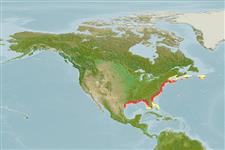Actinopterygii (ray-finned fishes) >
Perciformes (Perch-likes) >
Serranidae (Sea basses: groupers and fairy basslets) > Serraninae
Etymology: Centropristis: Greek, kentron = sting + Greek, pristis = saw (Ref. 45335).
Environment / Climate / Range
Ecology
Marine; reef-associated; oceanodromous (Ref. 51243); depth range 1 - ? m (Ref. 9988). Temperate, preferred 19°C (Ref. 107945); 45°N - 25°N
Western Atlantic: Canada (Ref. 5951) to Maine to northeastern Florida in USA and eastern Gulf of Mexico; reaches extreme southern Florida during cold winters.
Length at first maturity / Size / Weight / Age
Maturity: Lm 19.1 range ? - ? cm
Max length : 66.0 cm TL male/unsexed; (Ref. 40637); common length : 30.0 cm TL male/unsexed; (Ref. 3708); max. published weight: 4.3 kg (Ref. 4699); max. reported age: 20 years (Ref. 34089)
Commonly found around rock jetties and on rocky bottoms in shallow water. Marketed fresh and eaten fried, broiled and baked (Ref. 9988).
Life cycle and mating behavior
Maturity | Reproduction | Spawning | Eggs | Fecundity | Larvae
Also Ref. 32209, 103751.
Robins, C.R. and G.C. Ray, 1986. A field guide to Atlantic coast fishes of North America. Houghton Mifflin Company, Boston, U.S.A. 354 p. (Ref. 7251)
IUCN Red List Status (Ref. 115185)
CITES (Ref. 94142)
Not Evaluated
Human uses
Fisheries: commercial; gamefish: yes; aquarium: public aquariums
Tools
Special reports
Download XML
Internet sources
